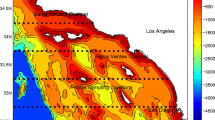Abstract
A grid transformation is described which isolates the Arctic and North Atlantic, rotates the spherical grid to pass an “equator” up the Atlantic through the north pole and remaps the Coriolis parameter. Boundary condition information is exchanged along the equatorial Atlantic so that the Arctic-Atlantic model is dynamically coupled to a model of the rest of the global ocean (which remains on the geographic spherical grid). The transform produces a more “regular” grid over the Arctic and eliminates the need for filtering or special treatment at the pole. The transform has been implemented in the GFDL Modular Ocean Model. After testing with idealized geometry, a 300 y global integration is compared to an integration using the geographic spherical grid and Fourier filtering. Results are similar, with differences in the Arctic and western North Atlantic regions leading to smaller air-sea heat flux near the Gulf Stream separation latitude for the transform case. Use of the transform also leads to a reduction in computation time.
Similar content being viewed by others
References
Aagaard K, Carmack EC (1989) The role of sea ice and other fresh water in the Arctic circulation. J Geophys Res 94:14485–14498
Aagaard K, Fahrbach E, Meincke J, Swift JH (1991) Saline outflow from the Arctic ocean: its contribution to deep waters of the Greenland, Norwegian and Iceland Seas. J Geophys Res 96:20433–20441
Bourke W (1972) An efficient one-level primitive equation spectral model. Mon Weather Rev 100:683–689
Browning GL, Hack JJ, Swarztrauber PN (1988) A comparison of three numerical methods for solving differential equations on a sphere. Mon Weather Rev 177:1058–1075
Bryan K (1969) A numerical method for the study of the circulation of the world ocean. J Comput Phys 4:347–376
Bryan K (1984) Accelerating the convergence to equilibrium of ocean-climate models. J Phys Oceanogr 14:666–673
Bryan K, Manabe S, Paconowski R (1975) A global ocean-atmosphere climate model. Part II The oceanic circulation. J Phys Oceanogr 5:30–46
Cox MD (1984) A primitive equation, three-dimensional model of the ocean, GFDL Ocean Group Tech Rep No 1. (Available from Geophysical Fluid Dynamics Laboratory, NOAA, Princeton University, Princeton, NJ 08542)
ETOP05 (1986) Global 5′ × 5′ depth and elevation. (Available from National Geophysical Data Centre, NOAA, US Dept of Commerce, Code E/GC3, Boulder, CO 80303)
Goldstein H (1950) Classical mechanics. Addison-Wesley, New York, pp 107–109
Hellerman S, Rosenstein M (1983) Normal monthly wind stress over the World Ocean with error estimates. J Phys Oceanogr 13:1093–1104
Herman GF, Johnson WT (1980) The effect of extreme sea ice variations on the climatology of the Goddard general ciculation model. In: Pritchard ED (ed) Sea ice processes and models. University of Washington, Seattle, pp 207–223
Hibler WD, Bryan K (1987) A diagnostic ice-ocean model. J Phys Oceanogr 17:987–1015
Killworth PD (1987) Topographic instabilities in level model OGCMs. Ocean Modelling 75 (unpublished manuscript)
Levitus S (1982) Climatological atlas of the World Ocean. NOAA Prof Pap No 13, US Governement Printing Office, USA
Orszag SA (1970) Transform method for calculation of vector coupled sums: application to the spectral form of the vorticity equation. J Atmos Sci 27:890–895
Pacanowski R, Dixon K, Rosati A (1991) The GFDL modular ocean model users guide version 1.0, GFDL Ocean Group Tech Rep No 2. (Available from Geophysical Fluid Dynamics Laboratory, NOAA, Princeton University, Princeton, NJ 08542)
Phillips N (1957) A map projection system suitable for large scale weather prediction. J Meteorol See Japan 75:262–267
Semtner AJ (1974) A general circulation model for the World Ocean. UCLA Department of Meteorology, Tech Rep No 8
Semtner AJ (1976) Numerical simulation of the Arctic ocean circulation. J Phys Oceanogr 6:409–425
Semtner AJ, Chervin RM (1988) A simulation of the global ocean circulation with resolved eddies. J Geophys Res 93:15502–15522
Starius G (1977) Composite mesh difference methods for elliptic and boundary valuable problems. Numer Math 35:241–258
Swarztrauber PN (1981) The approximation of vector functions and their derivatives on the sphere. SIAM, J Numer Anal 18:191–210
Author information
Authors and Affiliations
Rights and permissions
About this article
Cite this article
Eby, M., Holloway, G. Grid transformation for incorporating the Arctic in a global ocean model. Climate Dynamics 10, 241–247 (1994). https://doi.org/10.1007/BF00208991
Received:
Accepted:
Issue Date:
DOI: https://doi.org/10.1007/BF00208991




